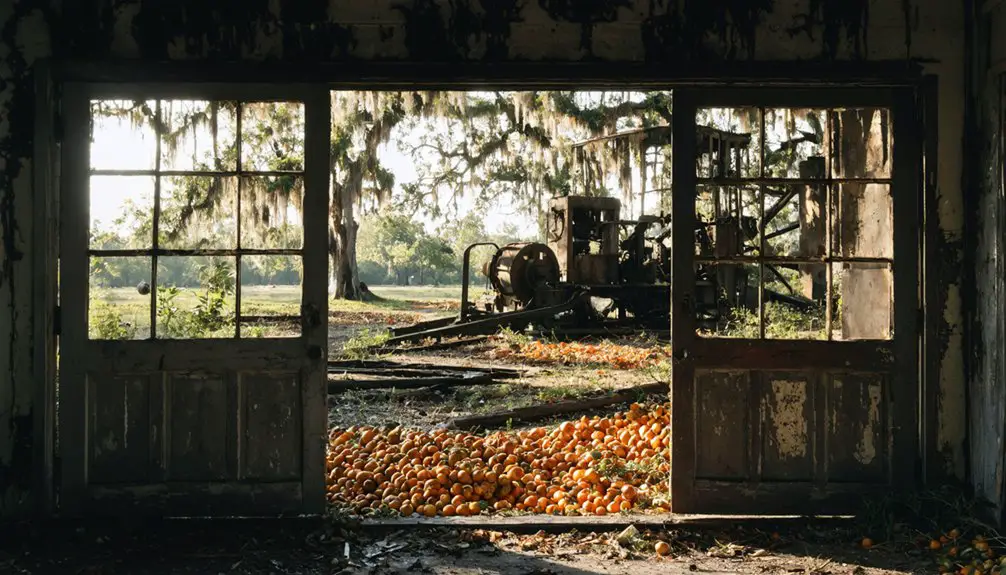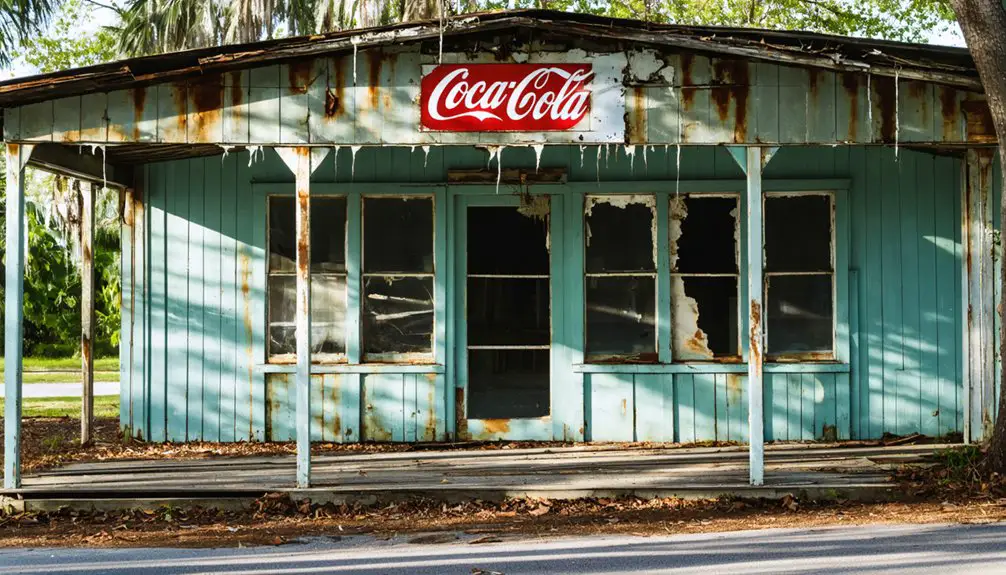You’ll find Sisco’s haunting remains along Florida’s Dunns Creek, where a bustling railway town once thrived in the 1880s. Founded in 1884 alongside the Jacksonville, Tampa and Key West Railway, this settlement boasted a post office, sawmill, and steamboat landing. The devastating Great Freeze of 1894-95 brought temperatures as low as 11°F, destroying the citrus industry and forcing residents to abandon their homes. Today, nature has reclaimed this lost piece of Florida’s pioneering spirit.
Key Takeaways
- Sisco was founded in 1884 along the Jacksonville, Tampa and Key West Railway as a vital transportation hub in Florida.
- The Great Freeze of 1894-1895 devastated local citrus production, causing land values to plummet from $1,000 to $10 per acre.
- Economic collapse forced families to abandon their homes and farms, transforming the once-prosperous agricultural community into a ghost town.
- No original structures remain today, with the post office, hotel, sawmill, railway extension, and steamboat stops completely vanishing.
- The site is accessible via rural roads but lacks signs or facilities, with only empty land and overgrown vegetation marking its former location.
The Birth of a Railway Settlement
While many Florida settlements emerged organically, Sisco’s birth in 1884 was deliberately tied to the expansion of the Jacksonville, Tampa and Key West Railway.
Unlike Florida’s naturally growing communities, Sisco was strategically founded in 1884 alongside the expanding Jacksonville, Tampa and Key West Railway.
You’ll find this strategic settlement’s origins in the vision of Henry W. and Claire Sisco, who recognized the potential along the Palatka & Indian River railway extension.
The settlement dynamics of this Putnam County town, located 10 miles north of Crescent City, centered entirely on railway construction and commerce. Similar to how disambiguation pages guide travelers to their correct destinations, Sisco served as a vital waypoint for railway passengers seeking various Florida destinations.
The town’s rail operations were reminiscent of the daily mixed freight trains that would later characterize Florida’s railroad services.
Henry W. Sisco quickly moved to establish the town’s legitimacy, gathering forty-one signatures for a post office petition in 1885.
As railway operations expanded, Sisco became an essential link in Florida’s late 19th-century railroad network, perfectly positioned to serve the region’s growing transportation needs.
Life Along Dunns Creek
You’ll find Sisco’s early maritime roots deeply connected to Dunns Creek, where steamboats regularly stopped for wood and water while transporting citrus products in the 1920s.
Much like the Kings Road system that early settlers relied on, the landing’s strategic location between Crescent Lake and the St. Johns River made it an essential link for regional commerce and transportation before modern roads took over.
The creek’s natural outflow supported not just steamboat traffic but also the town’s logging operations, connecting Sisco to the broader network of Florida’s waterborne trade. The steam sawmill operation was one of the town’s key facilities during its peak years of development.
Early Maritime Activity
Along the deep waters of Dunns Creek, early maritime activity played an essential role in shaping life and commerce in 19th century Florida.
You’d find steamboats regularly plying these waters, reaching depths of up to 30 feet as they carried citrus and supplies through the region’s crucial trade routes. Maritime trade flourished at the creek’s steamboat stop, where vessels would dock to take on wood and water while connecting Sisco’s residents to broader markets. Local residents engaged in turpentining and logging operations that supported the area’s economic growth.
The creek’s rich aquatic resources supported indigenous fishing practices for thousands of years before European settlement.
You can still trace this maritime heritage in the archaeological evidence left by the Mount Taylor and Orange culture peoples, who mastered these waters and built their lives around the creek’s abundant marine resources.
Steamboat Landing Operations
The bustling steamboat landings of Dunns Creek formed the heart of Sisco’s maritime commerce, connecting settlers to essential transportation networks across Florida’s waterways. You’d find the landing humming with activity as steamers carried passengers, citrus cargo, and supplies between Crescent Lake and the St. Johns River.
Similar to how French coureurs de bois established vital trading routes along waterways, Sisco’s steamboat logistics centered around carefully planned stops, where you could witness crews loading boxes of oranges and delivering wood and water to waiting vessels. The landing wasn’t just about cargo transportation – it served as a community hub, complete with a post office and facilities supporting local turpentining, farming, and cattle operations.
As you traveled the roads to these landings, you’d encounter drainage ditches and telephone lines, marking the intersection of maritime trade with evolving inland infrastructure.
A Religious Community Takes Root
Religious roots ran deep in Sisco’s early development, as evidenced by the Methodist Episcopal influence of its founders Henry and Claire Sisco in 1884. These religious foundations helped forge strong community cohesion among the initial settlers, who gathered 41 signatures for a post office petition just a year later.
You’ll find that religious and fraternal organizations played crucial roles in shaping Sisco’s social fabric. The African-American Masonic groups exemplified this through their management of a convalescence home in the former railway station. The religious history of Sisco was meticulously preserved through historical documents collected by dedicated archivists.
Their commitment to the community showed when they relocated their building rather than let Highway 17 destroy it. This spiritual foundation built upon the region’s rich religious heritage, which included layers of indigenous beliefs, Spanish Catholic missions, and Protestant traditions. Sisco Deen’s research helped document these religious influences that shaped the town’s early history.
Economic Growth and Transportation Hub
Building upon its spiritual foundations, Sisco’s economic significance stemmed from its strategic position as a transportation nexus in late 19th century Florida.
In late 19th century Florida, Sisco emerged as a vital transportation hub, building its economic strength upon earlier religious roots.
Similar to how wool production sites supported thriving communities in other regions, Sisco’s transportation evolution centered on its dual role as both a railway stop and steamboat landing. The town’s economic sustainability relied on its ability to move timber, citrus, and other goods efficiently through both water and rail networks. The seasonal flooding in the area required elevated railway construction to ensure reliable year-round transportation.
- The Jacksonville, Tampa and Key West Railway made Sisco a crucial link in Florida’s transportation chain.
- Dunns Creek steamboat stop served regional needs, including wood and water resupply.
- Steam sawmill operations capitalized on both rail and water shipping routes.
- Local hotel and general store supported travelers and commerce.
- Population of 60-150 people sustained the town’s role as a transport hub.
The Great Freeze’s Devastating Impact

You’d find Sisco’s thriving agricultural economy shattered when the devastating freezes of 1894-95 struck Florida, with temperatures plunging to record lows between 7 and 18 degrees Fahrenheit.
Your local citrus groves, which had drawn settlers and commerce to Sisco, were destroyed as ice split tree trunks and froze fruit solid on the branches.
When land values crashed from $1,000 to just $10 per acre, you’d see Sisco’s farmers and merchants facing financial ruin, unable to recover from such catastrophic losses.
Crop Devastation Hits Hard
The catastrophic Great Freeze of 1894-1895 released unprecedented devastation on Florida’s citrus industry, decimating Sisco’s agricultural foundation alongside countless other communities.
You’ll find that crop resilience was put to the ultimate test as temperatures plunged to 18°F in December and a brutal 11°F in February, destroying both fruit and trees.
Agricultural recovery wouldn’t reach pre-freeze levels until 1901, forcing many small growers to abandon their dreams.
- Florida’s citrus production crashed from 6 million boxes to just 100,000
- Land values plummeted from $1,000 to $10 per acre
- Over 21,700 acres of citrus groves produced zero boxes
- Communities like Sisco became ghost towns as farmers fled
- Only large growers with capital survived the seven-year recovery period
Town’s Economic Breaking Point
Beyond the agricultural devastation, Sisco’s economic foundation crumbled under the weight of the Great Freeze‘s financial impact.
You’d have witnessed property values plummet from $1,000 to just $10 per acre, destroying the wealth of local landowners and crushing their economic resilience.
As citrus production collapsed from 6 million boxes to a mere 100,000, Sisco’s families faced stark choices.
Some turned to tobacco farming and truck vegetables in a desperate bid for community adaptation, while others simply couldn’t hold on.
Without the capital to wait seven years for new citrus trees to mature, many residents were forced to abandon their homes.
The town’s social fabric unraveled as families rationed resources and relied on dwindling community support, ultimately leading to Sisco’s transformation into a ghost town.
What Remains Today: A Hidden Past
Nestled off U.S. Route 17 in Putnam County, you’ll find little evidence of Sisco’s hidden remnants. This once-bustling agricultural community has surrendered to nature, with its cultural significance now existing primarily in historical records.
Where steamboats once stopped and citrus groves flourished, only empty land and overgrown vegetation remain.
- No original structures survive – the post office, hotel, and sawmill have vanished
- The railway extension that connected Sisco to major transport routes is no more
- Former steamboat stops along Dunns Creek have disappeared completely
- You can access the site via rural roads, but don’t expect signs or facilities
- Some descendants of early settlers still own property nearby, preserving family ties
Today, Sisco stands as a monument to Florida’s harsh environmental challenges, its story preserved only in archives and local memory.
Frequently Asked Questions
Were There Any Notable Crimes or Lawlessness in Sisco’s History?
You won’t find records of crime incidents or significant law enforcement activity in this town’s history. The community maintained stability through its active years until environmental factors caused its decline.
What Happened to the Original 7th Day Adventist Settlers?
You’ll find the settlers gradually dispersed due to harsh conditions and limited resources. Their community struggles led them to relocate or join other congregations, while some families integrated into broader local religious communities.
Did Any Famous People Ever Visit or Live in Sisco?
You won’t find any records of famous visitors or celebrity sightings in this small rail town. The only notable residents were the founding Sisco family, who remained locally – not nationally – prominent.
What Was the Average Land Price During Sisco’s Peak Years?
While you’ll find specific prices aren’t documented, land values likely followed regional economic trends – moderate during railroad expansion but declining sharply after the devastating citrus freezes of the 1890s.
Were There Any Schools or Churches Built in the Town?
While you’d expect a religious colony to leave traces of church architecture and school history, there’s no definitive evidence of schools or churches being built in Sisco despite its Seventh-day Adventist founders.
References
- https://en.wikipedia.org/wiki/Sisco
- https://www.onlyinyourstate.com/experiences/utah/cisco-ut
- https://floridanature.wordpress.com/2008/10/19/hunting-for-a-ghost-town-in-the-forest/
- http://www.gribblenation.org/2018/04/ghost-town-tuesday-cisco-ut-and-old-us.html
- https://www.ghosttowns.com/states/fl/sisco.html
- http://thetracksidephotographer.com/2021/05/06/floridas-forgotten-shortline/
- https://study.com/academy/lesson/florida-railroad-history.html
- https://www.floridastateparks.org/parks-and-trails/dunns-creek-state-park/history
- https://flaglercountyhistoricalsociety.com/shell-bluff-park/
- https://floridadep.gov/sites/default/files/6 – DCSP_AG_DraftUMP.pdf



